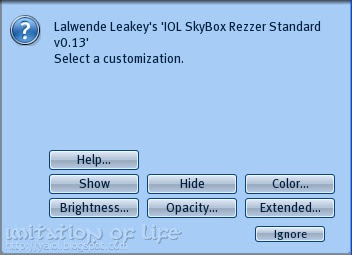Current release v0.15
Aide en Français
Texture Organizer helps to organize your textures very easily, visualize or retrieve them while preserving your inventory from any massive growth. You can assign your textures into any of the 50 buildin folders. Textures are viewable trough a 5x5 thumbnails grid (normal, magnified or tiled). Can be rezzed stand-alone or worn as HUD on any attachment point.
Here is a short summary of Texture Organizer features :
- Mono compiled (Very Fast)
- Copy/mod permissions (create as many Texture Organizer you want to store your collection)
- Works as HUD (Simply wear it)
- HUD with precise positioning, can be use with any attachment point, can be resized and minimized.
- Automatically scales wether it is rezzed stand-alone on worn has HUD
- Display up to 25 textures at once
- Texture can me magnified or tiled
- Unlimited texture capacity (successfully tested with 100,000 textures)
- 50 folders for outstanding organization
- Name folders
- Move easily a single texture from one folder to another
- Move easily all textures from one folder to another
- Give texture individual, folder, or all folders
- Delete individual texture or folder
- Remove duplicate textures by UUID (unlike others two ways: unprecise fast, precise slow)
- Search texture by name with partial matching term or not matching term
- Search texture by creator
- Sculpties visualization mode
- Smartprim to easily create your sculpties or apply your textures on faces for standard prim. (Change Sculpt Stitching)
- Shiped with a handy script to import textures stored into any mod box directly into your Texture Organizer
- Share textures easily with any TO owners (give individual textures, folder or all)
- Create share boxes easily (Give your textures easily to your friends)
- Customize configuration notecard (channel, permissions)
- When use stand-alone allow someone (avatar UUID), a group, or everyone to use device
- Full help within Imitation Of Life blog
Use it on ground or wear it as HUD
Texture Organizer can be either rezzed on ground or be worn as a HUD. Anyhow you will use, it will autoresize to fit.
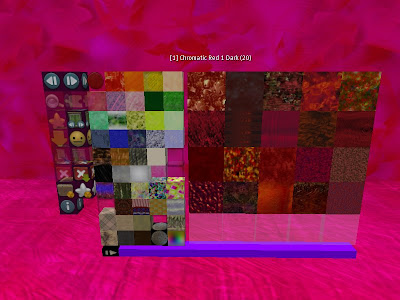 Rezzed on ground
Rezzed on groundYou can attach Texture Organizer on any HUD attachment point. It reminds its position until you use another attachment point.
Using Texture Organizer as HUD prevents consuming prim on SIM, thus it might be the best choice for most use. Rezzing Texture Organizer on ground might be needed if you want to share the devices with others while building.

Worn as HUDWhen used as HUD you can minimized Texture Organizer while clicking on upper right black square. To restore to standard user interface click on that box again.

Texture Organizer Interface

Texture Organize has three parts: on left side ten buttons that give access to most features, on bottom 50 folders containing unlimited number of textures, on top a panel of 25 thumbnails for viewing the textures.
Resize your Texture Organizer


Adding textures to Texture Organizer folders
Well you probably in hurry to use your Texture Organizer with your own textures. First thing I would advice is to copy the empty Texture Organizer that is shiped in the pack and rename it to whatever is suited. Once done wear your copy as HUD.
Edit Texture Organizer. Be sure to have selected the "Edit Linked Parts" checkbox. When done select one of the empty folder (on bottom of your Texture Organizer when worn as HUD). Select "Contents" panel. Open your inventory and simply drag your textures
(not the folder it won't work) from your inventory into the folder prim. Nothing else is needed.
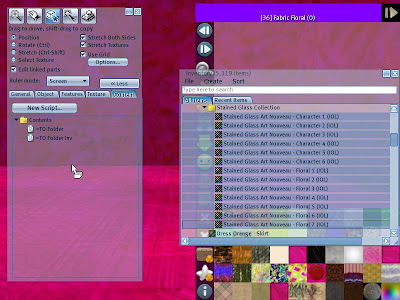
You can directly browse the new added textures.

You can also use a shortcut to directly drag textures from inventory into Texture Organizer folder, while holding [Ctrl] key and draging textures from inventory directly into folder. (You don't need to edit Texture Organizer at all).
Browsing through textures folders
For browsing through textures select the "Browse" button.
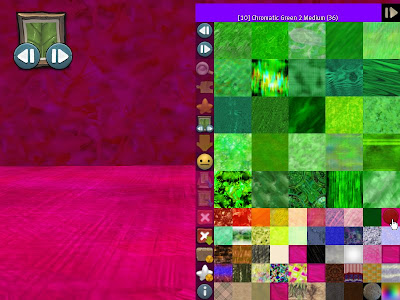
Click on a texture folder, for example the Green Medium. Texture Organizer show you on top blue bar some information on current selected folder : "[10] Chromatic Green 2 Medium (36)".
[10] is the number of folder,
Chromatic Green 2 Medium is the name of folder,
(36) is the number of textures into that folder.
If you click on a thumbnail Texture Organize shows name and UUID of selected texture. "Chromatic Green 2 Medium: Green Dramatic Moments - bb1f6767-fc73-dc76-31c9-b53c3afdd011
"

 |  | If current bank contents more than 25 textures you can browse using the previous and next buttons. |
Magnify & Tile
For magnify a texture use the "Magnify" button. When you will click a texture it will magnify using the 25 thumbnails. Click once again on any thumbnail to get back to previous view.

For tiling a texture use the "Tile" button. When you will click a texture it will tile it using the 25 thumbnails, click once again on any thumbnail to get back to previous view.

Searching through Textures
You can search within the current selected folder three ways:
/1= <term> to search texture with matching name
/1! <term> to exclude texture with matching name
/1c <term> to search by creator of texture
/1= will clear all active filter.
Select folder 43 and type on local chat
/1= denim.

You will see the five
Denim textures.
Type now
/1! denim
You will see all but the five
Denim textures.
Counting the textures

How to apply a texture
You can use Texture Organizer for applying textures directly to your prims. When using the "Pick Texture" Dialog select the "pipette" tool and pick the wanted texture currently drawn in one of the thumbnails. Due to a limitation of Second Life TM texture need to be into your inventory before using this feature. (See following chapter for uploading textures into your inventory).

Apply texture using SmartPrim
If you use
SmartPrim you wont need any textures into your inventory. Click on the SmartPrim icon, a white cube will rez 2 meters upon you head. Click on any face this will turn the face into yellow.

If you click on any texture it will be applied to all current "yellow" faces of all smartprim rezzed.

To select all faces of smartprim double click on any face.

If you select another texture this one will be applied now to all faces.

Once you apply all textures to all faces you can remove Smarprim script with command /1 spdone.

Uploading to inventory

| If you want to upload textures into your inventory select the Give button just below the browse button. |
You can upload either :
- one specific texture,
- one specific folder,
- all textures of your Texture Organizer.
The icon next to
Give indicates the target that will be used when copying textures. It can be yourself (your inventory), another
Texture Organizer or a
Sharebox.
 | Avatar Face means the target is yourself (textures will be uploaded to your inventory) |
 | The TO icon means target is another Texture Organizer (textures will be copied to another Texture Organizer) |
 | The "ShareBox" icon means current target is a ShareBox (textures will be copied into the ShareBox) |
 | The "synchronise" icon means your Texture Organizer is receiving textures from either another Texture Organizer or a Box using "Import Textures" script |
Uploading a texture
Now click on any texture you wanted. A dialog will popup to accept inventory offer. Click on "Keep" button.

The previous selected texture is now into your inventory.
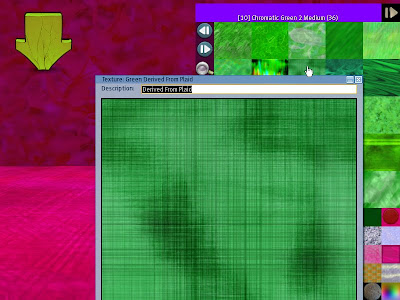
Uploading a folder
If you want to upload an entire folder you can click on folder. For example click on "Chromatic Multi-Colors 4 Rainbow: (13)" folder. As previously a dialog will popup to accept inventory offer.
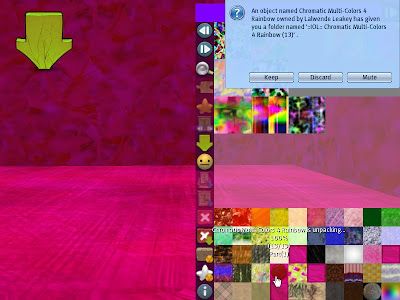
Open your inventory you will found the textures into the following folder "::iol:: Chromatic Multi-Colors 4 Rainbow (13)".
Uploading all folders
You can also uploading all folders at once while clicking the upper blue bar.

PS:Don't forget to click back on "Browse" button when ok.
Name of folders
You can easily setup name of folders while modifying the
.folders notecard within your Texture Organizer and type
/1 ren on public channel to apply.
.folders Notecard is defined as following:
- on line for each folder using semicolon separated fields: [folder number];[folder name]
- first line is used to setup the prefix that will be used when creating folder into inventory
.folders Example Notecard
0;::iol::
1;Chromatic Red 1 Dark
2;Chromatic Red 2 Medium
3;Chromatic Red 3 Orange
4;Chromatic Red 4 Yellow
5;Chromatic Red 5 Peach
6;Chromatic Pink 1 Dark
7;Chromatic Pink 2 Medium
8;Chromatic Pink 3 Light
9;Chromatic Green 1 Dark
...
Folder 1 will show Chromatic Red 1 Dark within Texture Organizer UI. If Uploaded the folder will be named "::iol:: Chromatic Red 1 Dark".
Moving all textures from one folder to another one
If you want to move all textures from on folder to another one. First select the source folder with "Browse command", click next the "Move All" button just below the "Give Inventory" button.

Now click to the desired target folder. A dialog will popup to accept move of textures from source to target folder. Click on "Yes" button to proceed.

Now click black to "Browse" button and select the Target folder once again. You will see the textures has been transfered.
Moving one texture from a folder to another one
If you want to move all textures from on folder to another one. First select the source folder with "Browse command", click next the "Move Texture" button just below the "Move All" button.

Now click to the desired target folder. It will glow in yellow.
Now any texture you will click on will be transfered from source to target folder. Let's try with clicking to some textures.

Now click black to "Browse" button and select the Target folder once again. You will see the previous clicked textures has been transfered.
Removing Textures
Manually remove textures
You can remove textures from your Texture Organizer using the 'Remove' button. By default Texture Organizer is using a remove safe state. To prevent lost of textures due to mistake, any textures will be upload to your inventory before beeing removede. If everything is ok you can then remove from inventory. If you made mistake you can still recover from inventory.


Automatic remove duplicate textures
Texture Organizer can find out duplicate textures in any of your folders and remove them. To have a test upload some texture of any folder and put them back into same folder as described in chapter
Customize the textures folders.
There are two ways to remove duplicate textures, one is precise but need many tests, one is unprecise but need a lot less.
In both case it only delete texture with same uuid whatever their names are.
If you get a folder with N textures
The precise algorithm needs N*(N-1)/2 test
For a 100 textures folder means 5050 tests, for 1K folder means 500500 tests, for a 5K means 12502500 tests.
But it detect all duplicates, if two textures have same key but have a very different name then precise will detect
The quicker way is to assume duplicates have same name like "wood thing", "wood thing 1" and "wood thing 2"
The unprecise algorithm needs only N-1 test, but it will miss textures with same uuid and named very differently like "wood chestnut" and "chestnut wood"
For a 100 textures folder needs 99 tests, for 1K folder 9999 tests, for a 5K needs 4999 tests
For instance If you can test 100 uuid pair in a sec you will need 34 hours for a 5K with precise algorithm but only 50 sec with unprecise one.
Now the remdup is shiped with option
/1 remdup near (default)
/1 remdup preciseType
/1 remdup on public channel.
You will see that Texture Organizer will recognize all the textures that has been duplicated and will remove them.
Texture Organizer will warn something like this.
Texture Organizer v0.8 - Fabric & Chromatic (1180): Remove Duplicate: Scanning of Fabric Fur done, [44/50]
Chromatic Red 1 Dark: Remove texture Red Noctua Lavoid 1
Texture Organizer v0.8 - Fabric & Chromatic (1180): Remove Duplicate: Scanning of Fabric Geometric done, [45/50]
Chromatic Red 1 Dark: Remove texture Red Kerstin Velvet 2 1
Chromatic Red 1 Dark: Remove texture petalos02.jpg 1
Texture Organizer v0.8 - Fabric & Chromatic (1180): Remove Duplicate: Scanning of Chromatic Red 1 Dark done, 4textures has been removed [46/50]
Texture Organizer v0.8 - Fabric & Chromatic (1180): Remove Duplicate: Scanning of Chromatic Multi-Colors 1 Misc done, [47/50]
Texture Organizer v0.8 - Fabric & Chromatic (1180): Remove Duplicate: Scanning of Fabric Stripes done, [48/50]
...
Texture Organizer v0.8 - Fabric & Chromatic (1180): Remove Duplicate: All scanning done, 4 textures has been removed
Change remove safe state
You can disable the 'remove safe' state. If disabled the textures wont be uploaded during the remove operations.
For changing 'remove safe' state. Type on public channel either
/1 remsafe off to disable or
/1 remsafe on to enable.
Working with sculpties textures
TO offers two differents ways to work with textures:
- a buildin visualization mode for using textures
- smartprim a way to create sculpties prims directly from your TO
Sculpties Visualization Mode
The best way to use Texture Organizer with sculpties textures is to sort them into specific folders. Once you will set your folders with your sculpties textures you can use the "Sculpties" visualization mode.
For testing purpose folder 50 has been filled up with 69 sculpties textures. Select the sculpties folder and select "Sculpties" (Tthe yellow five branches star icon below Tile). Thumbnails will be replaced with sculpties prims. You will notice this mode works either when your TO is rezzed into world or worn as HUD.
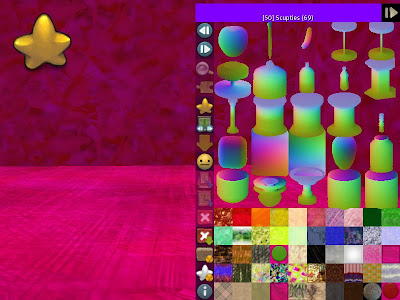
Smart Prim
You can also directly create your sculpties prims using SmartPrim feature. Click on the
SmartPrim icon, a white cube will rez 2 meters upon you head. Click on any facce and this prim will use that texture as "Sculptie".


Sharing Textures between two Texture Organizer
You can share your textures with friends very easily with Texture Organizer. Last button show current target of giving operations. By default avatar icon advices the target is you.
If you click on that button and a friend near to you also worn a Texture Organizer, both will begin an exchange protocol. The one who initiated the protocol will be the sender, the one accepting the exchange will be the receiver.
You can next send either:
- a single texture,
- an entire folder,
- even all textures in one operation
Initializing communication between Textures Organizers
To test the protocol exchange make a copy of Empty Texture Organizer and wear it to another attachment point (let's say top left). You should have two Texture Organizer on screen, on right side Fabric & Chromatic, on left side Empty.
Click on "Exchange" button of "Fabric & Chromatic", "Empty" will warn another Texture Organizer is initiating a exchange session
Do you accept receiving textures from. Accept.

You will notice icons on both Texture Organizer will change, on "Fabric & Chromatic" a "Texture Organizer" icon indicates current receiver is another Texture Organizer. On "Empty" an sychronize icon indicates you will receive textures.
Give a single texture
Now on "Fabric & Chromatic" Texture Organizer click on any folder and select the "Give button". If you click on any texture, instead of uploading it into your inventory this texture is send to the current selected folder of the target Texture Organizer.
Give a folder
To give a folder click on any folder.

Receiver will warn "To receive the [x] textures given by [Friend], click Yes and select target folder. Accept and select target folder, all textures will be copied into it.

Give all textures
To give all textures click on upper blue bar.
The receiver will warn "To receive the textures given by [Friend] click Yes."


You may find Texture Organizer
Shop in worldSecond Life Marketplace™





















